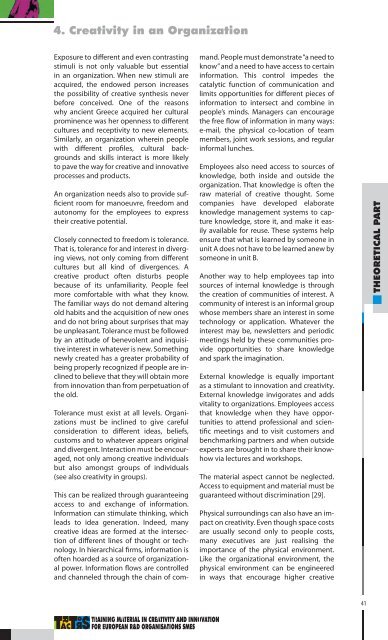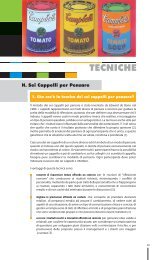Creativity Theory - TRaining MAterial in Creativity and InnovaTion ...
Creativity Theory - TRaining MAterial in Creativity and InnovaTion ...
Creativity Theory - TRaining MAterial in Creativity and InnovaTion ...
Create successful ePaper yourself
Turn your PDF publications into a flip-book with our unique Google optimized e-Paper software.
4. <strong>Creativity</strong> <strong>in</strong> an Organization<br />
Exposure to different <strong>and</strong> even contrast<strong>in</strong>g<br />
stimuli is not only valuable but essential<br />
<strong>in</strong> an organization. When new stimuli are<br />
acquired, the endowed person <strong>in</strong>creases<br />
the possibility of creative synthesis never<br />
before conceived. One of the reasons<br />
why ancient Greece acquired her cultural<br />
prom<strong>in</strong>ence was her openness to different<br />
cultures <strong>and</strong> receptivity to new elements.<br />
Similarly, an organization where<strong>in</strong> people<br />
with different profiles, cultural backgrounds<br />
<strong>and</strong> skills <strong>in</strong>teract is more likely<br />
to pave the way for creative <strong>and</strong> <strong>in</strong>novative<br />
processes <strong>and</strong> products.<br />
An organization needs also to provide sufficient<br />
room for manoeuvre, freedom <strong>and</strong><br />
autonomy for the employees to express<br />
their creative potential.<br />
Closely connected to freedom is tolerance.<br />
That is, tolerance for <strong>and</strong> <strong>in</strong>terest <strong>in</strong> diverg<strong>in</strong>g<br />
views, not only com<strong>in</strong>g from different<br />
cultures but all k<strong>in</strong>d of divergences. A<br />
creative product often disturbs people<br />
because of its unfamiliarity. People feel<br />
more comfortable with what they know.<br />
The familiar ways do not dem<strong>and</strong> alter<strong>in</strong>g<br />
old habits <strong>and</strong> the acquisition of new ones<br />
<strong>and</strong> do not br<strong>in</strong>g about surprises that may<br />
be unpleasant. Tolerance must be followed<br />
by an attitude of benevolent <strong>and</strong> <strong>in</strong>quisitive<br />
<strong>in</strong>terest <strong>in</strong> whatever is new. Someth<strong>in</strong>g<br />
newly created has a greater probability of<br />
be<strong>in</strong>g properly recognized if people are <strong>in</strong>cl<strong>in</strong>ed<br />
to believe that they will obta<strong>in</strong> more<br />
from <strong>in</strong>novation than from perpetuation of<br />
the old.<br />
Tolerance must exist at all levels. Organizations<br />
must be <strong>in</strong>cl<strong>in</strong>ed to give careful<br />
consideration to different ideas, beliefs,<br />
customs <strong>and</strong> to whatever appears orig<strong>in</strong>al<br />
<strong>and</strong> divergent. Interaction must be encouraged,<br />
not only among creative <strong>in</strong>dividuals<br />
but also amongst groups of <strong>in</strong>dividuals<br />
(see also creativity <strong>in</strong> groups).<br />
This can be realized through guarantee<strong>in</strong>g<br />
access to <strong>and</strong> exchange of <strong>in</strong>formation.<br />
Information can stimulate th<strong>in</strong>k<strong>in</strong>g, which<br />
leads to idea generation. Indeed, many<br />
creative ideas are formed at the <strong>in</strong>tersection<br />
of different l<strong>in</strong>es of thought or technology.<br />
In hierarchical firms, <strong>in</strong>formation is<br />
often hoarded as a source of organizational<br />
power. Information flows are controlled<br />
<strong>and</strong> channeled through the cha<strong>in</strong> of com-<br />
m<strong>and</strong>. People must demonstrate “a need to<br />
know” <strong>and</strong> a need to have access to certa<strong>in</strong><br />
<strong>in</strong>formation. This control impedes the<br />
catalytic function of communication <strong>and</strong><br />
limits opportunities for different pieces of<br />
<strong>in</strong>formation to <strong>in</strong>tersect <strong>and</strong> comb<strong>in</strong>e <strong>in</strong><br />
people’s m<strong>in</strong>ds. Managers can encourage<br />
the free flow of <strong>in</strong>formation <strong>in</strong> many ways:<br />
e-mail, the physical co-location of team<br />
members, jo<strong>in</strong>t work sessions, <strong>and</strong> regular<br />
<strong>in</strong>formal lunches.<br />
Employees also need access to sources of<br />
knowledge, both <strong>in</strong>side <strong>and</strong> outside the<br />
organization. That knowledge is often the<br />
raw material of creative thought. Some<br />
companies have developed elaborate<br />
knowledge management systems to capture<br />
knowledge, store it, <strong>and</strong> make it easily<br />
available for reuse. These systems help<br />
ensure that what is learned by someone <strong>in</strong><br />
unit A does not have to be learned anew by<br />
someone <strong>in</strong> unit B.<br />
Another way to help employees tap <strong>in</strong>to<br />
sources of <strong>in</strong>ternal knowledge is through<br />
the creation of communities of <strong>in</strong>terest. A<br />
community of <strong>in</strong>terest is an <strong>in</strong>formal group<br />
whose members share an <strong>in</strong>terest <strong>in</strong> some<br />
technology or application. Whatever the<br />
<strong>in</strong>terest may be, newsletters <strong>and</strong> periodic<br />
meet<strong>in</strong>gs held by these communities provide<br />
opportunities to share knowledge<br />
<strong>and</strong> spark the imag<strong>in</strong>ation.<br />
External knowledge is equally important<br />
as a stimulant to <strong>in</strong>novation <strong>and</strong> creativity.<br />
External knowledge <strong>in</strong>vigorates <strong>and</strong> adds<br />
vitality to organizations. Employees access<br />
that knowledge when they have opportunities<br />
to attend professional <strong>and</strong> scientific<br />
meet<strong>in</strong>gs <strong>and</strong> to visit customers <strong>and</strong><br />
benchmark<strong>in</strong>g partners <strong>and</strong> when outside<br />
experts are brought <strong>in</strong> to share their knowhow<br />
via lectures <strong>and</strong> workshops.<br />
The material aspect cannot be neglected.<br />
Access to equipment <strong>and</strong> material must be<br />
guaranteed without discrim<strong>in</strong>ation [29].<br />
Physical surround<strong>in</strong>gs can also have an impact<br />
on creativity. Even though space costs<br />
are usually second only to people costs,<br />
many executives are just realis<strong>in</strong>g the<br />
importance of the physical environment.<br />
Like the organizational environment, the<br />
physical environment can be eng<strong>in</strong>eered<br />
<strong>in</strong> ways that encourage higher creative<br />
41<br />
THEORETICAL PART



